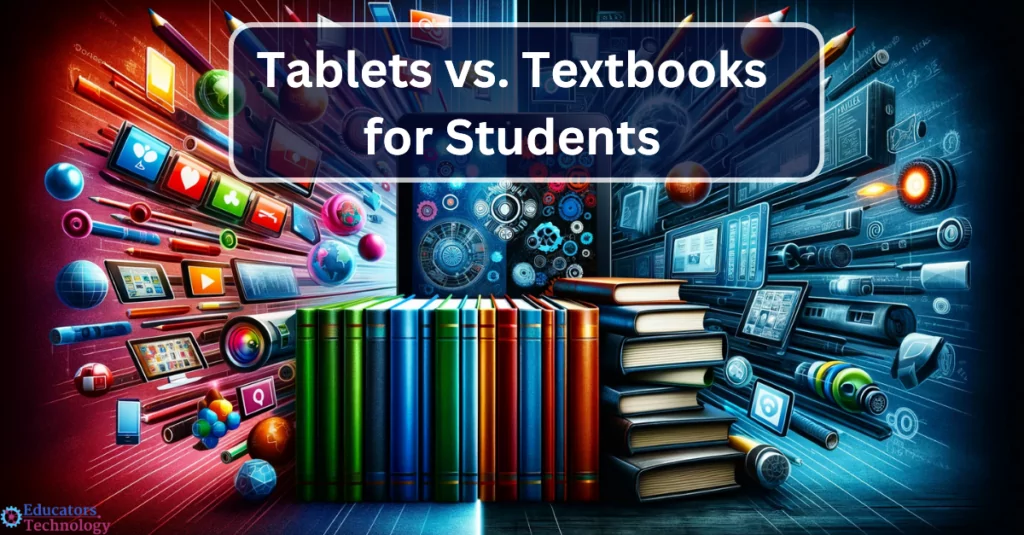In today's rapidly evolving educational landscape, the debate between tablets and textbooks has become increasingly relevant. As a former teacher and current educational researcher, I have witnessed firsthand the transformation of teaching tools from traditional methods to digital innovation. Let's dive deeper into this topic, exploring both sides of the argument, drawing on extensive research, classroom experiences, and the perspectives of educators and students alike.

Tablets versus textbooks for students
In this comparison between tablets and textbooks I cover the strengths and challenges of both, examining how the interactive and up-to-date digital content of tablets opposes the tactile and reliable nature of traditional textbooks. Drawing on a wealth of research, classroom experiences, and diverse student needs, this discussion aims to provide a nuanced perspective, considering factors such as student engagement, accessibility, cognitive impact, and readiness for a digital future.
The tablet case
1. Interactivity and Engagement: Tablets offer a dynamic learning environment. Interactive apps, videos, and simulations can bring complex topics to life in a way that textbooks cannot. This multimedia approach accommodates different learning styles, potentially increasing student engagement and understanding.
2. Updated information: Unlike textbooks, which can quickly become outdated, digital content can be updated in real time. This ensures that students always have access to the most up-to-date information, a critical factor in subjects such as science and social studies.
3. Accessibility: Tablets can be a great equalizer in education. They often include features for students with disabilities, such as screen readers or speech-to-text capabilities. Additionally, they can store hundreds of books on a single device, making learning resources more accessible, especially for students in remote or underfunded schools.
4. Preparing for a digital future: We are preparing students for a digital world. Familiarity with technology is vital to many modern careers. Tablets in classrooms can help students develop digital literacy skills from an early stage.
Best Related Tablets for Teachers
The case of textbooks
1. Reduced Screen Time: With growing concerns about the impact of screen time on student health, including eye strain and attention span issues, textbooks offer a tangible, screen-free learning option.
2. Reliability: Textbooks are not dependent on battery life or internet connectivity. They are always “on” and available, making them a reliable resource in classrooms with limited technology infrastructure.
3. Cognitive impact: Investigation suggests that reading physical books can improve comprehension and retention. The tactile experience of manipulating a textbook could help memory and understanding, a crucial factor in complex topics.
4. Cost and Durability: While the initial investment in tablets may be high, textbooks may, in the long run, be more economical, especially considering the potential costs of digital device repairs, upgrades, or replacements.
my perspective
Balancing tablets and textbooks is not a one-size-fits-all solution. In my experience, the best approach usually lies in a hybrid model that takes advantage of the strengths of both. For example, using tablets for interactive activities and textbooks for in-depth reading tasks can provide a well-rounded educational experience.
On my educational technology blog, I reviewed numerous digital tools and applications that can complement textbook learning. For example, augmented reality apps that bring historical events to life can be a great addition to history textbooks. Similarly, interactive math applications can turn abstract concepts into practical and engaging activities.
Looking to the future
As we navigate this debate, it is crucial to consider factors such as budget constraints, student needs, and educational goals. The decision should be based on what is best for students' learning experiences and outcomes.
Ultimately, whether through the pages of a textbook or the screen of a tablet, the goal remains the same: to provide students with the knowledge and skills they need to succeed in an ever-changing world. change. As educators and parents, our role is to guide them through these resources, ensuring they get the best of both worlds.
Sources and further reading
Here is a list of resources that discuss the comparison between tablets and textbooks in education:
- British“Pros and Cons: Tablets vs. Textbooks”: A Balanced View of the Tablets vs. Textbooks Debate in K-12 Schools.
- EDUCATE Review “Paper or tablet? Memory and reading comprehension” – A comparative study on the effectiveness of tablets and paper in reading comprehension.
- ProCon.org“Tablets vs. Textbooks” – A comprehensive resource offering expanded arguments, sources, and discussion questions on whether tablets should replace textbooks in K-12 schools.
- In “Long live the newspaper”, published in NYTimes.com October 9, 2012 Justin B. Hollander emphasizes the lasting value and effectiveness of paper in the digital age. He maintains that, despite the rise of digital media, paper remains a vital and effective medium for learning and communication, and offers unique advantages that digital formats cannot fully replicate.
- The document titled “iPad in educational results”, created by Apple, presents a comprehensive analysis of the impact and effectiveness of iPads in educational settings. It details several case studies and research findings that demonstrate how iPads enhance teaching and learning experiences through their interactive and engaging capabilities.






